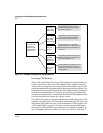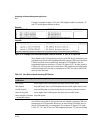
Configuring for Network Management Applications
CDP
and “E” are not neighbors because the intervening CDP-disabled switch “D”
does not forward CDP packets; i.e. is not transparent to CDP traffic. (For the
same reason, switch “E” does not have any CDP neighbors.)
CDP Switch "A"
(CDP Running)
CDP Neighbor Table
Port | Data
-------|--------------------
A1 | Host 1 data
A1 | Host 2 data
A1 | Host 3 data
A2 | Switch "B" data
CDP Workstation "1"
(Host 1)
(CDP Running)
Non-CDP Device "X"
Such as a Non-CDP
Hub or Switch
CDP Workstation "2"
(Host 2)
(CDP Running)
Non-CDP Device "Y"
Such as a Non-CDP
Hub or Switch
CDP Workstation "3"
(Host 3)
(CDP Running)
CDP Switch "B"
(CDP Running)
CDP Neighbor Table
Port | Data
-------|--------------------
B1 | tch "A" data
B7 | Switch "C" data
No CDP data for Switch
"D" because it has dis-
abled CDP operation.
Port A1
Port B1
CDP
Switch "C"
(CDP Running)
CDP Neighbor Table
Port | Data
-------|--------------------
C3 | Switch "B" data
Port C3
Port B7
CDP-Disabled
Switch "D"
(No CDP Neighbor Table)
This switch drops CDP packets.
CDP Switch "E"
(CDP Running)
CDP Neighbor Table
Empty-No CDP
Neighbors
Port A2
Port D3
Port D17
Port E1
"A", "1", "2", and "3" are CDP neighbors.
"A" and "B" are CDP neighbors.
"B" and "C" are CDP neighbors.
Because "D" is CDP-capable, but has
disabled CDP, it is not a CDP neighbor
to either "B" or "E".
Port B5
Swi
Figure 13-12. Example of Incoming CDP Packet Results
13-29


















